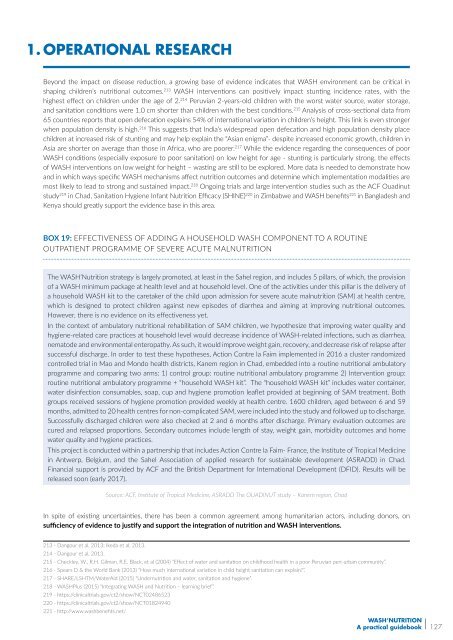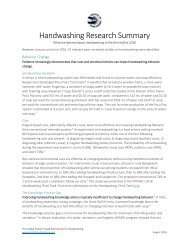WASH’ Nutrition
manuel_wash_nutrition_online
manuel_wash_nutrition_online
Create successful ePaper yourself
Turn your PDF publications into a flip-book with our unique Google optimized e-Paper software.
1. OPERATIONAL RESEARCH<br />
Beyond the impact on disease reduction, a growing base of evidence indicates that WASH environment can be critical in<br />
shaping children’s nutritional outcomes. 213 WASH interventions can positively impact stunting incidence rates, with the<br />
highest effect on children under the age of 2. 214 Peruvian 2-years-old children with the worst water source, water storage,<br />
and sanitation conditions were 1.0 cm shorter than children with the best conditions. 215 Analysis of cross-sectional data from<br />
65 countries reports that open defecation explains 54% of international variation in children’s height. This link is even stronger<br />
when population density is high. 216 This suggests that India’s widespread open defecation and high population density place<br />
children at increased risk of stunting and may help explain the “Asian enigma”- despite increased economic growth, children in<br />
Asia are shorter on average than those in Africa, who are poorer. 217 While the evidence regarding the consequences of poor<br />
WASH conditions (especially exposure to poor sanitation) on low height for age - stunting is particularly strong, the effects<br />
of WASH interventions on low weight for height – wasting are still to be explored. More data is needed to demonstrate how<br />
and in which ways specific WASH mechanisms affect nutrition outcomes and determine which implementation modalities are<br />
most likely to lead to strong and sustained impact. 218 Ongoing trials and large intervention studies such as the ACF Ouadinut<br />
study 219 in Chad, Sanitation Hygiene Infant <strong>Nutrition</strong> Efficacy (SHINE) 220 in Zimbabwe and WASH benefits 221 in Bangladesh and<br />
Kenya should greatly support the evidence base in this area.<br />
BOX 19: Effectiveness of adding a Household WASH component to a routine<br />
outpatient programme of Severe Acute Malnutrition<br />
The <strong>WASH’</strong><strong>Nutrition</strong> strategy is largely promoted, at least in the Sahel region, and includes 5 pillars, of which, the provision<br />
of a WASH minimum package at health level and at household level. One of the activities under this pillar is the delivery of<br />
a household WASH kit to the caretaker of the child upon admission for severe acute malnutrition (SAM) at health centre,<br />
which is designed to protect children against new episodes of diarrhea and aiming at improving nutritional outcomes.<br />
However, there is no evidence on its effectiveness yet.<br />
In the context of ambulatory nutritional rehabilitation of SAM children, we hypothesize that improving water quality and<br />
hygiene-related care practices at household level would decrease incidence of WASH-related infections, such as diarrhea,<br />
nematode and environmental enteropathy. As such, it would improve weight gain, recovery, and decrease risk of relapse after<br />
successful discharge. In order to test these hypotheses, Action Contre la Faim implemented in 2016 a cluster randomized<br />
controlled trial in Mao and Mondo health districts, Kanem region in Chad, embedded into a routine nutritional ambulatory<br />
programme and comparing two arms: 1) control group: routine nutritional ambulatory programme 2) Intervention group:<br />
routine nutritional ambulatory programme + “household WASH kit”. The “household WASH kit” includes water container,<br />
water disinfection consumables, soap, cup and hygiene promotion leaflet provided at beginning of SAM treatment. Both<br />
groups received sessions of hygiene promotion provided weekly at health centre. 1600 children, aged between 6 and 59<br />
months, admitted to 20 health centres for non-complicated SAM, were included into the study and followed up to discharge.<br />
Successfully discharged children were also checked at 2 and 6 months after discharge. Primary evaluation outcomes are<br />
cured and relapsed proportions. Secondary outcomes include length of stay, weight gain, morbidity outcomes and home<br />
water quality and hygiene practices.<br />
This project is conducted within a partnership that includes Action Contre la Faim- France, the Institute of Tropical Medicine<br />
in Antwerp, Belgium, and the Sahel Association of applied research for sustainable development (ASRADD) in Chad.<br />
Financial support is provided by ACF and the British Department for International Development (DFID). Results will be<br />
released soon (early 2017).<br />
Source: ACF, Institute of Tropical Medicine, ASRADD The OUADINUT study – Kanem region, Chad<br />
In spite of existing uncertainties, there has been a common agreement among humanitarian actors, including donors, on<br />
sufficiency of evidence to justify and support the integration of nutrition and WASH interventions.<br />
213 - Dangour et al, 2013; Ikeda et al, 2013.<br />
214 - Dangour et al, 2013.<br />
215 - Checkley, W., R.H. Gilman, R.E. Black, et al (2004) “Effect of water and sanitation on childhood health in a poor Peruvian peri-urban community”.<br />
216 - Spears D & the World Bank (2013) “How much international variation in child height sanitation can explain?”.<br />
217 - SHARE/LSHTM/WaterAid (2015) “Undernutrition and water, sanitation and hygiene”.<br />
218 - WASHPlus (2015) “Integrating WASH and <strong>Nutrition</strong> – learning brief”.<br />
219 - https://clinicaltrials.gov/ct2/show/NCT02486523<br />
220 - https://clinicaltrials.gov/ct2/show/NCT01824940<br />
221 - http://www.washbenefits.net/<br />
<strong>WASH’</strong><strong>Nutrition</strong><br />
A practical guidebook<br />
127



